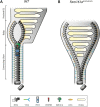A defective structural zipper in photoreceptors causes inherited blindness
- PMID: 35714125
- PMCID: PMC9205488
- DOI: 10.1371/journal.pbio.3001672
A defective structural zipper in photoreceptors causes inherited blindness
Abstract
Being able to see the beauty of this world is a wonderful thing unfortunately unavailable to people with inherited blindness. In this issue of PLOS Biology, Mercey and colleagues present optimized expansion microscopy for retinal tissue, which represents a huge step forward in our ability to study these blinding conditions.
Conflict of interest statement
The authors have declared that no competing interests exist.
Figures

Comment on
-
The connecting cilium inner scaffold provides a structural foundation that protects against retinal degeneration.PLoS Biol. 2022 Jun 16;20(6):e3001649. doi: 10.1371/journal.pbio.3001649. eCollection 2022 Jun. PLoS Biol. 2022. PMID: 35709082 Free PMC article.
References
Publication types
MeSH terms
LinkOut - more resources
Full Text Sources

